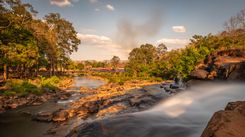Rows of drink shops, competing to quench the thirst of Vietnamese truckers, signal your arrival in BAN DONG, a popular stop on any tour of the Ho Chi Minh Trail. Villagers are slowly growing accustomed to tourists poking around for a glimpse of the Republic of Vietnam’s American-made tanks left over from one of America’s most ignominious defeats during the war, at the battle known as Lam Son 719.
The tank that’s easiest to find lies five minutes’ walk off the road that cuts south out of town towards Taoy, which was once a crucial artery of the Ho Chi Minh Trail. Shaded by a grove of jackfruit trees, it rests atop a small hill east of the road, and has been partially dismantled for its valuable steel. Ban Dong was cleared of unexploded war debris in 1998, but it’s still a good idea to ask a villager to show you the way, as you should always take extra care when leaving a well-worn path, and vegetation in the rainy season can obscure the tank’s location. If you’re travelling by public transport, the best time to visit Ban Dong is in the morning, as there are no late-afternoon buses plying this stretch of highway. Guesthouses in Xepon may be able to help you organize a round-trip.




